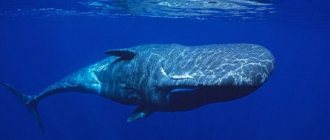- Wild animals
- >>
- Mammals
The humpback whale , or as this animal is affectionately called, the long-armed minke whale, is a large aquatic mammal that lives in the seas and oceans around the world. The humpback whale is considered one of the most agile whales that puts on real performances, jumping out of the water column and loudly plopping back onto the water. For their acrobatic performances, the whales have gained a reputation as funny whales.
Geographic range and habitat
Humpback whales, also called humpbacks or minke whales, are found in all oceans and several seas. Their entire population was divided by scientists into 4 subpopulations according to their habitat:
- Atlantic;
- North Pacific;
- South Pacific;
- Indian Ocean.
Photo: whale_nerd
The first three subpopulations of humpback whales migrate to the Atlantic and Pacific Ocean regions. The inhabitants of the Indian Ocean do not migrate; for the most part they are isolated. Their range is limited to Asia (north), Antarctica (south), Australia and the Philippines (east), and Africa (west).
Humpback whales' habitat includes polar and tropical waters, including the waters of the Arctic, Atlantic and Pacific oceans, as well as the waters surrounding Antarctica and the Bering Strait. During migration, they are found in coastal and deep ocean waters.
Fishing
Humpback whales, relatively slow-moving whales closely associated with the shore, were easily exterminated. In the past they have been heavily fished in areas around South Georgia, the South Shetland Islands, South Africa (Natal, Angola), Congo, Madagascar, Australia, New Zealand, Japan, Korea and the Pacific coast of North America. A 12.92 m long male weighed on the Aleut weighed 27,714 kg, of which (in kg): subcutaneous fat 2847, peritoneum 3734, tongue 792, meat 5788, vertebrae 2669, raw skull 2247, lower jaw 1103, ribs with muscles 3718, pectoral fins 1016, shoulder blades 578, caudal fins 455, heart 125, liver 327, lungs 362, stomach 105, internal fat 443 and other parts 1405 kg.
After the fishing ban, humpback whale numbers began to recover, so the species' status on the IUCN Red List was changed from Endangered to Vulnerable in 1990. Currently, the greatest threats to humpback whales are ship strikes and ocean noise pollution, although these do not appear to have a serious impact on their numbers. In addition, humpback whales, lacking the ability to echolocate, cannot detect the location of fishing nets and often die after becoming entangled in them. The latter is a significant problem in the waters of Newfoundland and Labrador and the Gulf of Maine, where humpback whales damage up to 90% of cod nets.[11] Between November 1987 and January 1988, 14 humpback whales died after eating Atlantic mackerel contaminated with saxitoxin. The traditional breeding grounds of humpback whales are under threat due to disturbance factors such as the passage of sea vessels and boats and the abundance of tourist boats, although, in general, this species adapts relatively easily to human proximity.
physical characteristics
The most characteristic external features of humpback whales are the size, shape and color of the fins, as well as the whalebone.
Appearance
Humpback whales have a characteristic stocky body shape combined with a noticeable hump. The color of the back is dark and dull. Characteristic bumps called bumps spread throughout the scalp and jaw (a distant memory of hair follicles).
Photo: Canadian Wildlife Federation
The breathing holes of humpback whales consist of two parts and open simultaneously due to muscle contractions. The long-armed minke whale exhales with such force that the air leaving the lungs instantly condenses upon contact with cold atmospheric air. Such an exhalation can reach three meters in height .
Fins
The caudal fin is wide, symmetrical, heart-shaped, with linear grooves. Its top is black and its bottom is white. Each humpback whale has a unique pattern on the underside of its caudal fin, which allows observers to recognize certain individuals.
Photo: Patrick Davis
Humpback whales have the longest pectoral fins of any cetacean, which can account for almost a third of their body length. Compared to the body size and length of other fins, the dorsal fin is relatively small. It has a triangular (humpbacked) shape. This is especially clearly visible when long-armed minke whales jump above the surface of the water.
Whalebones
The jaw of the humpback whale is equipped with dark-colored whalebone plates. The front plates are about 45 cm long, while the plate at the back of the whale's jaw can be 90 cm long. They allow the animal to filter water, which results in drying out the plankton in its mouth. There can be 270-400 horny plates in the mouth of a humpback whale.
Subcutaneous fat
Humpbacks have the largest relative blubber thickness for their size of any baleen whale. In terms of absolute thickness of subcutaneous fat, they are second only to blue whales, or blue whales. The thickness of blubber varies depending on the time of year, age and physical condition.
Male and female: main differences
Sexual dimorphism in humpback whales lies in the size of males and females. Females are slightly larger, on average 1-2 meters longer and several tons heavier than males. In addition to size, the urogenital zone differs in structure: males do not have a hemispherical protrusion (diameter 15 cm) at the tip of the urogenital fissure.
Dimensions
Female humpback whales are larger than males. This is one of the few mammal species that has this feature.
- Body length: 13-14 meters, maximum 19 meters (males); 15-17 meters, maximum 27 meters (females)
- Weight: 25 tons, maximum 40 tons (males); 30 tons, maximum 90 tons (females)
- Length of pectoral fins: up to 6 meters
- Tail fin width: 2-3 meters
Eating habits
Like minke and fin whales, humpback whales are versatile hunters. They are very mobile and opportunistic. They feed on plankton, plants and animals on the surface of the water or crustaceans on the ocean floor. Because of this, humpbacks are classified as "swallowers" rather than "skimmers".
Large volumes of water and food can fit in the mouths of these baleen whales because the ventral grooves allow the throat to expand. When the mouth is completely filled, the humpback whale closes it and squeezes out the water. At the same time, food enters the horny plates and is then swallowed. This process is facilitated by powerful language.
Humpback whales have unusual dietary habits - they feed only in the summer, using up their reserves of subcutaneous fat in the winter. At this time of year, humpback whales feed very rarely, mostly passively foraging for food.
Photo: Donna Pomeroy
Bony fish make up about 95% of the diet of North Atlantic humpbacks. Individuals from these areas feed on krill, mackerel, Atlantic herring, sand lance, Atlantic salmon, sardines, haddock, anchovies, capelin, and cod.
Northern Pacific humpbacks feed on mackerel, saury, Pacific and Arctic cod, pollock and greenling. They also feed on a variety of invertebrates.
The favorite food of individuals living in New Zealand and Australia is krill, bottom crustaceans, amphipods, and schooling fish. Cephalopods appear much less frequently on their menu.
Diving underwater
The duration of diving for humpback whales depends on the time of year. In summer they rarely dive for more than 5 minutes, and dives lasting more than 10 minutes are rare. In winter, dives last 10-15 minutes (maximum 30 minutes). During the winter season, whales appear to dive underwater to rest; in the summer, they rest on the surface of the water. On the surface, the humpback whale releases fountains 2 to 5 m high at intervals of 4-15 s. The way it raises its tail fin when diving deep makes this whale one of the most easily identified species of cetaceans, since each individual is distinguished by an individual pattern of spots on the lower part of the tail blades.
Hunting tactics
The easiest way to get food is to hunt together (a group consists of 6 to 14 whales, sometimes 2 or 3 individuals in the case of hunting shallow-water fish). Humpback whales can also conduct a direct attack, surrounding the entire school and stunning the prey with tail whips. They can also feed using baleen plates, but this method is more complex than that of other cetaceans.
In cooperation with other long-armed minke whales, humpback whales surround the fish from below and from the sides, gradually narrowing the circle. Several members of the group confuse shallow-water inhabitants by jumping above the surface of the water and creating splashes with their tails. One humpback whale dives as deep as possible and exhales so that air bubbles push the fish closer to the surface. Then there is a direct attack on the prey.
Stunning fish with low-frequency sounds is considered one of the most difficult hunting methods.
Appearance and features
Photo: What a humpback whale looks like
The long-armed minke whale is one of the largest creatures on our planet. The average weight of an adult is about 30 tons. Body length is about 15 meters in females and 12.5-13 in males. However, there are particularly large individuals whose length reaches 19 meters and weight up to 50 tons. Sexual defromism in favor of females. Externally, females differ from males only in the size and structure of the dropped zone. The whale's body is dense and shortened. The body is widened in front, thinned at the back and slightly compressed at the sides.
The head is large and ends in a rounded snout. The lower jaws are well developed, strong and seem to be pushed forward a little. The skull is wide-cheeked. The eyes are small. The nostrils of this species are located at the top of the head and form a blowhole. On the head, from the blowhole to the snout, there are about 4 rows of skin growths similar to warts.
In the middle row there are 6-8 growths, on the sides from 6 to 15. In front of the lower jaw there is a rather large growth with a diameter of up to 32 centimeters. All growths are altered hair follicles; a hair grows from each growth. The size and location of growths, as well as the coloring of whales, are individual. The whale has a large drooping belly.
The belly has longitudinal throat folds that stretch from the chin to the navel. When eating, these folds expand significantly, allowing the whale to swallow a large volume of water. There are about 20 folds in total, the folds are white.
Interesting fact: The humpback whale has a very dense layer of subcutaneous fat, which allows the animal to go without food for a long time and live in cold waters.
The fins on the chest are especially long; their length is equal to 30% of the length of the whale’s body. Thanks to such long fins, the whale can swim well and jump high above the water. The fin located on the back is small, only about 32 cm. The rear edge of the fin is often curved in the shape of a sickle. The anterior edge of the fin is gentle.
The tail has a large and massive fin with a jagged edge. Humpback whales can have a wide variety of colors. The back and sides of the whale are usually black or dark gray. There are white furrows on the chest and sides. The fins located on the chest are dark or spotted above, and often light or white below. The tail is dark on top, and can be either light or spotted below.
There are 7 vertebrae in the neck. The internal organs are protected by 14 thoracic vertebrae, 10 lumbar and 21 caudal vertebrae. The humpback whale releases a large v-shaped fountain; the height of the fountain can reach three meters.
Communication and perception
Humpback whales (both male and female) make unique sounds. The male "call sign" is based on very loud and long sound sequences called songs. Each song consists of low-frequency sounds of varying heights and amplitudes. One song can last up to 20 minutes , although there are recordings of males singing for 24 hours with breaks only for breaths. It is worth noting that humpback whales do not have vocal cords ; their songs are created solely by exhalation through giant blowholes.
Photo: X-Ray Mag
Each subpopulation has its own set of songs. During migration, new sounds are “picked up” from groups they meet, with whom newcomers willingly communicate.
The purpose of these songs has not yet been determined by scientists. It was generally believed that the sounds made by males were a form of courtship, however it was found that these messages were also responded to by other males. Therefore, it is generally accepted that this method of communication helps to establish a hierarchy of males in a certain area. As already mentioned, when hunting, humpback whales also use low-frequency sound waves to disorient their prey.
Whalebone
Each row of baleen contains from 270 to 400 ash-black plates with a hard brown (light gray in juveniles) fringe (occasionally the plates in the front part of the row are half white on the vomer side). The greatest height of the plates is about 1 m, usually no more than 85 cm. Every year the plates grow by 8-11 cm. The thickness of the fimbriae in the middle of their length is 0.47-0.82 mm, on average 0.62 mm, and at their base 0.6 -1.0 mm. There are 42-50 fimbriae per 1 cm of length along the fringed edge of the plate.
Social structure
Humpback whales are solitary whales , although they sometimes live in small temporary groups that come together for only a few hours. These mammals prefer company mainly during the summer season. The purpose of the group is to hunt schools of fish and crustaceans. The strongest bonds are between females and their young.
Despite the fact that humpback whales live in the same areas as their cetacean cousins, they show no signs of interspecific activity. The only exception is in the Hawaii area, where young minke whales often swim alongside bottlenose dolphins.
Sometimes humpback whales exhibit aggressive behavior towards their relatives . Individuals “accompanying” the young become aggressive towards other humpback whales approaching the group. They sometimes blow soap bubbles from their blowholes or mouth, creating a “screen.” It is believed that most of the “escorts” are males.
In general, groups of humpback whales are more aggressive than solitary whales. Defensive or agonistic behavior may include body bumping and tail lashing. Such aggression may also be directed at approaching boats. When competing for food, humpback whales may also clash with other cetaceans and many seabirds.
Nutritional Features
Humpback whales feed mainly in feeding areas; During migrations and in wintering areas, they predominantly starve, subsisting on reserves of subcutaneous fat. During wintering they lose up to 25-30% of their weight. Humpback whales feed on benthic and pelagic crustaceans, schooling fish, and, less commonly, cephalopods and pteropods. Due to the peculiarities of their diet, whales stick to coastal waters and the continental shelf. The stomach of a humpback whale can hold up to 500-600 kg of food.
Humpback whales have the most diverse repertoire of feeding techniques among baleen whales, with the most commonly observed being:
- During feeding, a humpback whale with its mouth open swims into a school of fish or plankton, swallowing food along with water. Then the mouth is closed and the water is filtered through a filter apparatus in such a way that the food is retained on the fringe of the whalebone, from where it is scraped off with the tongue and swallowed. As a rule, the whale rises vertically from the depths.
- A group of whales surrounds a school of fish and churns the water with their fins, creating a “ring of foam” that the fish cannot escape. At the same time, some of the whales use their screams to drive the fish away from the created “barrier.” Then the whales take turns diving under the ring with their mouths open, swallowing the fish.
- Similar to the previous one, but the whale is underwater, exhaling air from its blowhole and thus creating a cloud of bubbles. While feeding, the whale gradually rises to the surface. The cloud of bubbles apparently confuses prey and helps the whale camouflage itself. Thus, whales can hunt either alone or in groups, surrounding prey in a circle or semicircle and spiraling up to the surface.
The latter two techniques often require the coordinated actions of several individuals, representing some of the most complex joint actions among marine mammals. It is curious that this behavior is observed exclusively in northern whale populations. Another technique used by solitary whales is stunning prey with tail blows. At the same time, the whale swims in a large circle, hitting the water with force with its tail and thereby stunning the fish. In another technique, the whale plunges sharply underwater, where it makes a 180° turn (in a U shape) and slowly rises to the surface through a zone of turbulence created by the impact of its fins.
Seasonal migration
Humpback whales migrate seasonally from the tropics to their northern feeding grounds. In the tropics they are found in dense clusters on shallow shores. They usually migrate into the deep ocean from feeding grounds to breeding grounds. At great depths they spread wider than in shallow waters.
Humpback whales migrate between northern and southern latitudes in sync with the climate cycle . Migration is largely related to two factors: nutrition and reproduction. Minke whales regularly leave colder waters (where whales feed in the spring, summer and fall) and swim to shallow tropical shores (where humpbacks breed in the winter). These cetacean mammals also tend to move through coastal waters during migrations when they encounter land masses in their direct path.
In the spring, humpback whales appear in large numbers in subarctic waters and remain there until summer. The humpbacks migrate, apparently, because they are looking for warmer water in which they can bear their young.
Humpback whales dive to a depth of 6-7 meters, staying under water for 15-20 minutes. Swimming speed can reach 27 km/h , and during migration - from 3.8 to 14.3 km/h. Humpback whales with calves swim the slowest, while solitary whales move faster than individuals in groups.
Interesting Facts:
- The vocal repertoire of humpback whales is famous and plays an important role in their reproduction. Female humpback whales are capable of making different sounds, but only males sing long and melodiously. The song of a humpback whale is a specific series of frequency-modulated sounds in the range of 40-5000 Hz, which lasts 6-35 minutes, and is often repeated. Males sing especially actively if females with cubs are nearby. They can sing either one at a time or in chorus. This “choral singing” makes it possible to track the migration routes of whales.
- The humpback whale is the most recognizable and famous species of all whales. In all coastal regions of the planet where humpback whales are found, they become a favorite attraction for tourists who love to watch whales jump out of the water, blow fountains and listen to their songs.
Breeding season and young development
Humpback whales attempt to court potential mates during winter during their migration to equatorial regions. Moreover, a male may show interest in a pregnant female or even already a mother.
The female has a hemispherical lobe, about 15 cm in diameter, located in the genital area, which allows males to distinguish females from below. The male reproductive organ is usually hidden in a special fold of skin, and their head and back are covered with scars - memories of battles with larger opponents.
Packs of 20-30 males usually surround a female or a small group of females, displaying their skills:
- jumping above the surface of the water;
- slap the water with their tails;
- roll over onto their backs and alternately slap their pectoral fins on the water;
- raise the dorsal part of the head horizontally to the surface, and then submerge again under the water without moving forward.
Photo: Andrew Hendry
Such displays can even last several hours, as rejected males are soon replaced by new suitors.
There is little real scientific data on the copulation process of this species. The male and female are known to swim in a line first; then they roll, turn over and swish their tail. After this, both dive and emerge vertically, with their ventral surfaces “in close contact.” The pair emerges from the water to a point below the fins, falling back to the surface of the water together.
Pregnancy lasts more than 11 months . During this time, the embryo grows from approximately 17 to 35 cm per month. Females are viviparous, newborns reach 6 meters in length and weigh up to two tons (the size of the cub depends on the size of the mother). Whales are born tail first , which protects their lungs from water. The fins of a young humpback whale have a soft structure, which makes it a clumsy swimmer; its mother is forced to help it move.
Photo: Hawaii Magazine
The first goal after birth is to float to the surface to take your first breath. The baby humpback whale has excellent vision and hearing. He is breastfed for about 6 months and feeds on his own for the next 6 months. The milk of females is very nutritious and contains large amounts of fat, protein, lactose and water.
After 11 months, young animals begin to swim with adults during hunting in order to learn how to obtain food by exhaling air bubbles. They become experts in this matter after reaching the age of two. Young individuals gain complete independence at the age of 4 years.
Reproduction usually occurs once every two years, but can occur twice every three years. In the latter case, lactation lasts longer than 5 months. If the female is fertilized soon after giving birth, pregnancy and lactation can occur simultaneously.
Photo: Lewis Burnett
- Mating system: polygynous
- Breeding interval: every 1.5-2 years
- Average number of offspring: one cub
- Gestation period: from 11 to 11.5 months
- Age range at sexual or reproductive maturity: 4 to 5 years (both males and females)
Description of a mammal
There are three suborders of cetaceans. 38 genera live in our time, 127 are extinct. The animal belongs to the minke whale family and the suborder of baleen whales.
Another name for the creature is humpback whale. It is associated with the shape of the dorsal fin and the manner of movement. The first records of this animal were made in 1756.
What does it look like
It is impossible to confuse the mammal with another species; it looks unique. The length of the female is approximately 14 meters, males - 13.5 meters. Average weight – 30 tons. Fat accounts for approximately 7 tons. Females are noticeably larger in size than males.
The body is dense and widened in front, compressed laterally at the back. The whale's jaws are well developed. The nostrils are located at the top of the large head. From them to the snout there are 4 rows of skin growths, which are modified hair follicles.
The animal has a large hanging belly with longitudinal folds. Thanks to this structure, the whale can swallow a large volume of food. Subcutaneous fat allows the sea giant to remain in cold water for a long time without food.
The length of the fins on the chest is 30% of the entire body. Due to them, the creature swims beautifully and jumps high above the surface of the water. The dorsal fin is about 0.5 m long. Its posterior edge is curved.
The humpback can have a wide variety of colors. The back and sides are usually black or dark gray, the fins are spotted above and light below. An unusual albino humpback whale with a completely white color was spotted off the coast of Australia. A similar anomaly occurs in one individual out of 40 thousand.
Character and lifestyle
Humpback whales live in large herds, but still prefer a solitary lifestyle. Females never leave their babies. The behavior of the animals is similar to that of dolphins. They are playful and love to frolic. Over the water surface, mammals launch torpedoes and perform acrobatic stunts.
The way of life largely depends on migration. In their usual environment, creatures stay at shallow depths. Here they fatten up, gaining subcutaneous fat.
Before wintering, whales migrate to areas with a warm climate - to the seas of Colombia, Japan, and Mexico. Individuals move slowly, covering about 10-15 kilometers per hour. A lone humpback whale does not pose a danger to people. However, there are cases where a group of whales attacked boats and boats.
By abruptly jumping out of the water, whales try to throw off the parasites living on their bodies. And animals cannot stay under water all the time, because they breathe air.
What does it eat?
Favorite food: tiny shrimp-like animals called krill. The humpback fish can eat up to 1.5 tons of small crustaceans per day. The diet is based on bottom and pelagic crustaceans and mollusks.
North Atlantic populations feed primarily on fish:
- herring;
- mackerel;
- capelin;
- navaga;
- cod;
- haddock.
The humpback whale has a variety of feeding techniques. For example, a group of whales surrounds fish and creates a foam ring of water, beyond which small waterfowl cannot escape.
Afterwards, the individuals take turns diving under these rings, mouths open. In this way they swallow large quantities of fish. They eat fish, shellfish, algae and other sea creatures, but they especially like krill.
There is a black whisker in the mammal's mouth. It hangs from the upper palate and consists of many plates. This device serves to sift out the main food and separate it from water. The sticky surface of the mustache is inhabited by commensals - organisms that feed on leftover food. They do not harm their owner.
Where it lives and migration routes
In ancient times, the humpback whale lived in almost all seas and oceans. Most whales have been recorded in the Baltic and Mediterranean seas.
Today, two large herds live in the North Atlantic. A large number of individuals live in Antarctic waters. They periodically change their habitat, but do not travel far from their permanent residence. There is a small population in the Indian Ocean.
On the territory of the Russian Federation, the humpback whale can be seen in the Sea of Okhotsk, Chukchi, Japan and Barents. Here animals are under serious protection. Humpback whales constantly migrate and search for places where krill live. Seasonal migrations are noted.
Every year, thousands of tourists travel to distant countries to look at giant animals and admire them in person. However, you do not need a passport for this meeting. On the eastern coast of Kamchatka, humpback and gray whales have fun from May to August. They stay in shallow water and almost completely jump out of the water.
During migration, humpback whales use navigation mechanisms to help them stay on track.
Social structure
Mammals are very smart. Whale families communicate in their own dialect and know common songs. They receive knowledge from their mothers. Only males sing. Their voices can be heard 30 km away.
The songs of humpback whales last up to 30 minutes. Animals do not form families. The female takes care of the cubs.
Reproduction
The mating season occurs in winter. At this time, you can hear the whales singing, which they use to attract potential partners. Females that are ready to mate live in calm, shallow waters.
Having found the chosen one, the humpback whale begins to pursue her and does not allow other males to approach her. Clashes often arise between rivals. The individuals mate, and then the male immediately swims away. After the mating season, the whales travel to the polar regions, where they actively fatten for 3 months, and then return to warm waters.
After 10-12 months, the female gives birth to a cub. It weighs from 700 kg to 1.5 tons. Height at birth is approximately 5 meters. Throughout the first year, the baby feeds on mother's milk.
The little whale grows up very quickly. A year after birth, its height reaches 9 meters. During this time, the mother loses a lot of weight. The animal reaches sexual maturity at the age of 6 years.
The question of why a whale is a mammal and not a fish should not arise. Baby giants do not hatch from eggs, but are born by live birth. Baby whales feed on their mother's milk, like other mammals.
The female gives birth to one cub over several years.
Natural enemies
The humpback has almost no enemies in the wild. One has only to note the killer whale attacking the cubs. Small parasites poison the lives of animals:
- baleen crustaceans;
- lice;
- trematodes;
- scrapers.
The main enemy remains man. Animal meat is highly valued. Various items are still made from whalebone. A sea giant may not notice how a diver, numb with fear, will fall into its mouth along with a school of fish.
The good news is that no matter how hard you want, a person cannot fit into the esophagus of a mammal, the diameter of which is only 10 cm. The whale will simply spit out everything unnecessary, including the diver.
Lifespan
Lifespan of humpback whales: 45-100 years. However, recent research shows that they can live up to 200 years. The record was confirmed by amino acid analysis - 211 years.
Long-armed minke whales have no natural enemies other than humans. Juveniles are also often targeted by killer whales, with sharks feeding on their dead bodies.
Some humpback whales have whitish, oval-shaped scars that are caused by parasitic sea lampreys. Humpback whales are the most parasitized of all minke whales. They are carriers of a wide variety of ecto- and endoparasites. The high number of parasites may be related to the swimming speed of this species. The slow pace of humpbacks is thought to encourage the accumulation of parasites.
Photo: Donna Pomeroy
Story
In the history of the Earth there were several stages in the relationship between people and whales. The oldest is approximately 50-55 million years ago, during the Miocene era, when our ancestors and the ancestors of whales fed in the shallow waters of the World Ocean. Most likely, there was no rivalry - both the methods of eating and the food itself were different. Human ancestors, having found a large piece, bit off the food and then chewed it; the ancestors of whales swallowed various small things whole. Then, for some reason, our ancestors came to land, and the whales went to sea forever.
True, some of their ancestors left with us, forming the class of artiodactyls. So whales are also artiodactyls in some way. It’s not surprising - we’re not all like monkeys either. Comparing the structural features of the skeletons, scientists believe that the closest land relative of the whale is the hippopotamus.
Economic importance for people
Humpback whales have historically had incredible economic importance to people. They were one of nine species of whales that were actively hunted by whalers. At times they were the most important part of their catch. Humpback oil was in demand as fuel for lamps and lubricant for cars. Whale oil was also used as a raw material for margarine and a component of cooking oil. Humpback whale meat was processed for human consumption and used as animal feed. Whale bone meal was used as fertilizer.
However, these animals are no longer hunted on a large scale. They continue to have some economic importance for people as ecotourism and whale watching tours are quite popular in modern times.
On the other hand, humpback whales that stay close to shore on Canada's east coast often damage cod and herring traps and can tear long sections of net.
Origin of the species and description
Photo: Humpback whale
Megaptera novaeangliae The humpback whale or humpback whale is a very large aquatic mammal that belongs to the family of minke whales, a suborder of baleen whales. Species of humpback whale. Whales are mammals, and their ancestors are considered to be ancient predatory ungulates, mesonychians. The animals are somewhat similar in appearance to wolves with hooves and sharp claws on them. So the closest relatives of whales in the modern world can be considered not fish, but rather hippos.
The most similar to modern whales in the ancient world are considered to be mammals from the family Protocetidae, which led an amphibiotic lifestyle, but in structure were already more similar to modern whales. The nasal openings of these animals were shifted upward, and these animals also already had an almost fish-like tail.
Video: Humpback whale
The next stage in the evolution of whales were the basilosaurs - these creatures lived about 38 million years ago. They were the size of modern whales and had a fatty frontal protuberance that was responsible for echolocation. These animals show degradation of their limbs due to their almost complete transition to an aquatic lifestyle. The limbs are still well developed, but they are very small and cannot be used for movement.
The next stage in the evolution of cetaceans was the toothed whales, which inhabited the waters of our planet from the middle Oligocene to the middle Miocene. This is approximately 34-14 million years ago, these creatures actively used echolocation, swam well in water and lost contact with land. The most ancient species of humpback whale, Megaptera miocaena, lived on our planet in the late Miocene.
The remains of these animals are known in the Pleistocene and late Pliocene. The humpback was first described by Mathurin Jacques Brisson as the "baleine de la Nouvelle Angleterre" which translated means "The Whale of New England" in 1756 in his work The Animal Kingdom. Later, Georg Barowski renamed the animal, translating its name into Latin Baleana novaeangliae.
French ichthyologist Bernard Germain Hélén de la Ville, Count Lacepède changed the classification and name of this species of whale. He also described one of the oldest fossil whale species, Megaptera miocaena, which lived in the late Miocene.
Save Status
Currently, up to 60,000 humpback whales live in earth's waters. The largest populations are found in the western North Atlantic. Global populations of humpback whales have begun to increase, although the species remains a source of concern to scientists.
Humpback whales received some protection in 1985 when the International Whaling Commission imposed a moratorium on commercial whaling. In the early 20th century, during the era of modern whaling, humpback whales were highly vulnerable due to their tendency to congregate in tropical breeding areas and move closer to shore in northern feeding areas.
More than 60,000 humpback whales were killed in the southern hemisphere between 1910 and 1916, and the 1930s and 1950s also saw peak harvests. In the North Pacific, a peak catch of more than 3,000 fish was recorded in 1962-1963.
Natural enemies of humpback whales
Photo: Humpback whale
Due to their enormous size, humpback whales have virtually no enemies in the wild. Of the natural enemies of whales, only the killer whale can be noted, which can attack baby whales. However, these giant creatures are seriously poisoned by small parasites.
The most common parasites that live on whales include:
- copepods;
- whale lice;
- baleen crustaceans;
- roundworms;
- trematodes;
- nematodes, scrapers, etc.
But the main enemy of these huge creatures was and remains man. Whales have long been the object of whaling, and in the 20th century, about 90% of these animals were exterminated, now hunting, and a ban on whales was introduced. But several whales are still killed every year. Whale meat is highly valued, and whalebone is also highly valued, from which many items are made.
With the introduction of a hunting ban, the whale population began to gradually recover. Today, the main concern is the pollution of the water bodies in which whales live. Due to climate change, water pollution, and harmful chemicals entering the water, fish and small crustaceans, which are food for whales, are dying. Besides. non-degradable garbage gets stuck in the digestive tract of whales, which can cause the animal to die.
Did you know?
- The common name "humpback" also comes from the animal's tendency to round its back when diving.
- Humpback milk is pink and contains 50% fat.
- The long-armed minke whale can create characteristic sounds without exhaling air. Supposedly, air circulates inside his head, creating a resonance of certain organs.
- One individual can eat several thousand fish in one hunt.
- Humpback whales leap 3 meters above the water's surface, but the most skilled of them often perform 6-meter leaps.
- The cerebellum of humpback whales makes up about 20% of the total brain mass; The structure of the brain is not very different from the brain of other baleen whales.
- The olfactory organs of humpback whales are greatly reduced, and perhaps they have no sense of smell at all.
- Long-armed minke whales have narrow external auditory canals that lead to a tiny hole on the head near the eye.











